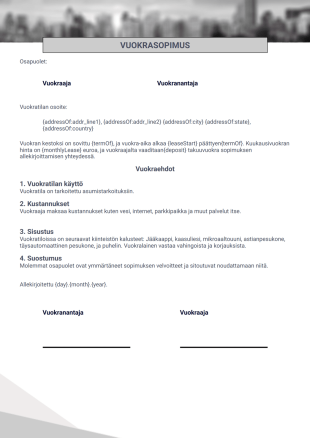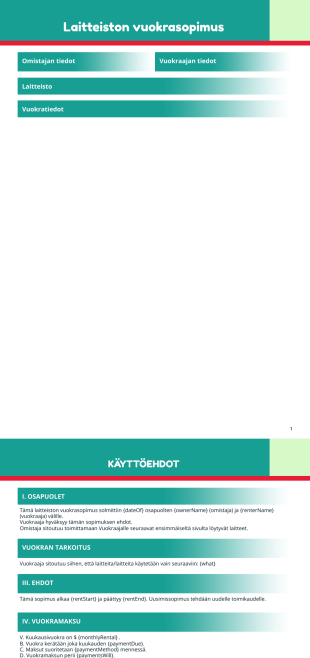Rental Agreement Templates
About Rental Agreement Templates
A rental and lease agreement is a document that outlines the arrangement between an owner of a property, known as the “landlord” or “lessor,” and someone who pays rent to occupy the property, known as the “tenant” or “lessee.” It can apply to either commercial or residential property. Once signed, the agreement is considered legally binding for both parties.
You can use Jotform Sign, our dedicated e-signature tool, to create your own agreement. Jotform Sign automatically generates a PDF copy of the signed agreement that can be printed, stored, or shared. Plus, there’s no need to design a PDF agreement from scratch — just use one of our rental agreement templates. You can fully customize the template, add your own branding, modify the terms and conditions, and more.
Usein kysytyt kysymykset
1) What is a lease agreement?
A lease agreement is a contract between a landlord and tenant that outlines the terms by which the tenant can rent property from the landlord, such as the duration of the lease, the monthly rent amount, and the maintenance responsibilities of each party.
To lease an apartment, a tenant will apply using a rental application provided by the landlord. The landlord will review the application and usually conduct a credit check and employment verification. They may also collect an application fee.
If the lessee’s application is approved, the landlord will send them a lease, which the lessee must sign and return with a security deposit. The lessee will then be able to move into the apartment under the terms determined by the lease.
2) Who needs a residential lease agreement?
Anyone involved in leasing a property should have a residential lease agreement that defines the terms of the lease and keeps all involved parties protected by law. These individuals include property managers looking for tenants, social service providers looking for supportive housing, real estate agents, and anyone renting or looking to lease property.
3) What is the difference between a lease and a rental agreement?
A rental agreement typically provides for tenancy for a short period of time, usually 30 days. Unless the renter or landlord provides a move-out notice, the lease is automatically renewed.
A lease provides the tenant the right to occupy the property for a specific period of time, which typically runs from six months to a year or more. Unless the tenant agrees, the terms of the lease cannot be changed by the landlord, except in some cases where the law permits the landlord to raise the rent after a defined period of time.
Also, a lease does not usually renew automatically for the same period of time. If a tenant continues to stay at the property, the agreement converts to month-to-month terms until a new rental or lease agreement is signed. These conditions are not unique to real property. People also rent or lease equipment, automobiles, and other items.
4) Can I write my own lease agreement?
Yes, you can. A lease is an agreement between you (the landlord) and your tenant. Leases usually include standard items, such as the amount of rent, the duration of the lease, who is responsible for various maintenance tasks, and the consequences for not following the terms.
Jotformin avulla voit luoda vuokrasopimuspohjan ja käyttää lomaketta kerätäksesi tietoja, jotka muuttuvat jokaisen vuokrasopimuksen yhteydessä, kuten vuokralaisen nimi, vuokrasumma jne. Voit myös hyväksyä digitaalisia allekirjoituksia, kun on aika allekirjoittaa lopullinen asiakirja.
5) What are some terms I should include in a lease agreement?
- Term, Conditions: State the length of the lease period, as well as terms and conditions.
- Rent: Include the amount of rent and when it is due.
- Security deposits and fees: Declare whether you require a security deposit and first/last month’s rent.
- Names of all tenants: Include every adult who will live on the property.
- Occupancy limits: Specify who can occupy the property.
- Restrictions on use of the property: Language regarding whether certain things are prohibited, such as excessive noise and illegal activity.
- Pets: Whether the lessee can have pets, and if so, what kind and how many.
- Maintenance and repairs: Outline who is responsible for what types of maintenance and repairs of the property.
- Utilities: Establish who is responsible for utilities, and what will happen if a payment is delinquent.
- Entry to the property: Clarify the landlord’s rights to access the property to make repairs, and how much advance notice you will provide.
6) Can a rental or lease agreement be used as proof of address?
In many cases, a valid rental or lease agreement can be used as proof of address. You can use Jotform to produce a PDF version of the lease for your tenant.
7) Is a lease cancellable?
A lease is usually for a fixed term, such as one year. However, a landlord may waive any penalties and allow a tenant to break a lease. You are advised to consult an attorney and your local real estate laws.
8) Does a lease need to be notarized?
A lease is a contract between a landlord and a tenant. Usually, it does not need to be notarized. Jotform allows you to include digital signatures, such as DocuSign, on your lease agreement, which are usually legally binding.
9) Glossary of lease agreement terms
- Landlord (lessor): A landlord is a person who owns land, houses, or apartments and rents or leases them to tenants.
- Vuokralainen: Vuokralainen on henkilö, joka vuokraa maata, tiloja tai omaisuutta vuokranantajalta.
- Security deposit: A security deposit is paid by an incoming tenant in order to secure the lease from a landlord. It can either be a partial payment toward the tenant's monthly rent or a security measure for the landlord in the event of property damages. Under most security deposit laws, your deposit is considered refundable and must be returned to you within a specific time period after you move out, unless the lessee or renter has caused or allowed damage to the property.
- Common area maintenance (CAM): Common area maintenance (CAM) fees — common in commercial and industrial leases —are paid in part or whole by tenants to help cover expenses for internal and external common areas like hallways, elevators, shared bathrooms, parking areas, and more. CAM fees vary by circumstance, so amounts should be agreed upon by both the landlord and the tenant and explicitly laid out in their contract.
- Renewal option: A renewal option is included in a rental or lease agreement and outlines the terms and conditions for extending the original agreement. Landlords are not required to extend or renew a lease without a renewal option outlined in the agreement, so it’s important to include a renewal option if the lessee/renter intends on renewing the lease.
- Periodic tenancy: Periodic tenancy is the possession of a property with no determined end date. As opposed to a fixed-term tenancy, the tenant decides when to end the tenancy. This is especially common for month-to-month rentals.
- Pet addendum: If landlords allow pets, they will include a pet addendum that requires tenants to provide detailed information about their pet, like breed, age, size, and description. This allows landlords to keep accurate records in case of damage and monitor renter compliance.
- Inspection checklist: A renter inspection checklist allows renters to document the status of the apartment before their lease begins so that landlords can assess new damage at the end of a lease. They protect both the landlord and the tenant from misunderstandings or disagreements.
- Guarantor: A guarantor is the person responsible for taking care of and paying for the property if the primary tenant fails. Guarantors are often required for student lease agreements, or for tenants without steady employment.
- Cosigner: A cosigner is a third-party person that shares the responsibility of paying rent with the primary tenant, though they are not required to live on the property.
- Lease allowance: Lease allowances are money or items that the landlord gives the tenant to improve the rental space.
- Amenities: Amenities clauses in the lease consider logistical arrangements with tenants, such as parking or storage space. Because amenities provide an additional convenience, they may come at a price specified in the lease.
Renter’s insurance: Insurance products help tenants pay for the risks associated with commercial leasing. Some landlords may require that tenants pay for renter’s insurance in the lease.
Nämä pohjat ovat vain malleja lomakkeille. Jos käytät lomaketta sopimuksena tai keräät henkilökohtaisia (tai arkaluontoisia) tietoja, suosittelemme että varmistat noudattavasi sovellettavia lakeja, ja varmistat sopimusten laillisuuden maassasi asianajajasi kanssa.


